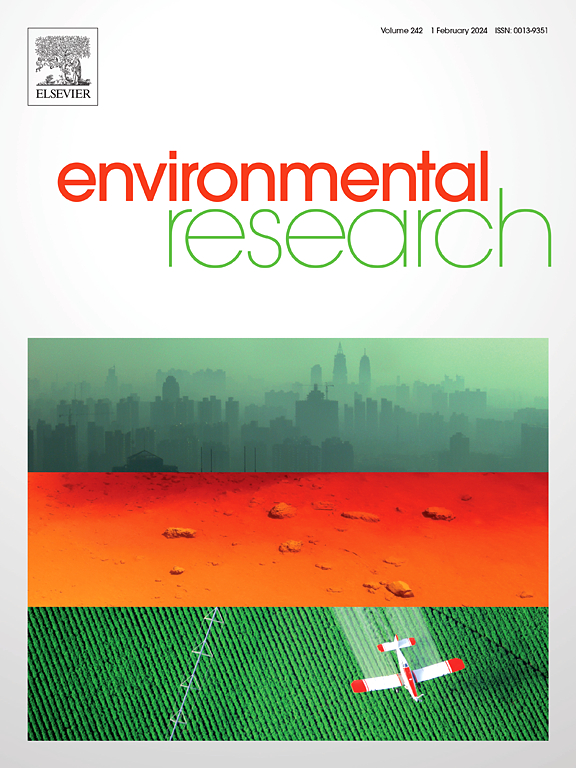极端降雨事件对华南亚热带喀斯特河流溶解碳的大影响
IF 7.7
2区 环境科学与生态学
Q1 ENVIRONMENTAL SCIENCES
引用次数: 0
摘要
喀斯特流域亚热带河流中溶解有机和无机碳(DOC和DIC)的动态变化对降雨强度表现出明显的敏感性,特别是在极端水文强迫下。由于南海接收了全球河流碳通量的6.2-10.3%,因此解决这一气候敏感地区降雨制度与碳动态之间的机制联系对于限制全球陆地-海洋碳收支至关重要。通过对具有代表性的华南岩溶集水区旱季、季风期和台风事件的采样,我们展示了三种降雨强度依赖的碳路径。极端降雨触发了陆地-水生碳的快速运输,使DOC浓度升高40-174%(平均13.4 mg/L)。从荧光指数(FI: 1.98-2.16)、生物指数(BIX: 0.71-1.03)和较高的蛋白样成分(41-63%)可以看出,新鲜、生物可利用的溶解有机物(DOM)在这些脉冲中占主导地位。同时,水停留时间的缩短抑制了碳酸盐风化作用,形成了13c -枯竭型河流水系DIC (δ13C-DIC: -24.9‰~ -18.8‰,HCO3-: 33.8 ~ 67.7mg/L)。持续的中等降水通过长时间的水-岩相互作用促进了碳酸盐岩的完全溶解(δ13C-DIC富集至平均值-13.6‰,HCO3-: 38.0 ~ 65.7 mg/L)。微生物代谢降解不稳定DOC (FI: 1.69-1.81;蛋白样成分:0-48.6%),留下顽固性腐殖质底物(SUVA254: 2.3-7.2 L/mgC/m)和较低的DOC浓度(平均:4.9mg/L)。旱季基流表现出藻类介导的碳循环:光合DIC吸收富集δ13C-DIC(-16.7‰~ -8.3‰),而原生DOC产量保持中等水平(平均9.5 mg/L),坡度比较高(SR: 0.88 ~ 1.46)。这些发现建立了降雨强度-碳物种形成矩阵,揭示了水文极端事件优先于快速DOC转移而不是DIC生成,中等降雨最大化风化源DIC,基流维持水生碳释放。本研究强调了亚热带河流中DOC和DIC对降雨事件的敏感响应,为研究亚热带喀斯特系统陆水碳动态过程提供了新的见解。本文章由计算机程序翻译,如有差异,请以英文原文为准。
Large effects of extreme rainfall event on dissolved carbon in a subtropical karst river in South China
The dynamics of dissolved organic and inorganic carbon (DOC and DIC) in subtropical rivers within karstic catchment exhibit pronounced sensitivity to rainfall intensity, particularly under extreme hydrologic forcing. Because the South China Sea receives 6.2–10.3 % of global riverine carbon fluxes, resolving the mechanistic links between rainfall regimes and carbon dynamics in this climate-sensitive region is critical for constraining global land-ocean carbon budgets. Through sampling across dry seasons, monsoon periods, and typhoon events in a representative South China karstic catchment, we demonstrate three rainfall-intensity-dependent carbon pathways. Extreme rainfall triggered rapid terrestrial-aquatic carbon transporting, elevating DOC concentrations by 40–174 % (mean: 13.4 mg/L). Fresh, bioavailable dissolved organic matter (DOM) dominated these pulses, evidenced by fluorescence index (FI: 1.98–2.16), biological index (BIX: 0.71–1.03), and higher protein-like components (41–63 %). Concurrently, shortened water residence times suppressed carbonate weathering, yielding 13C-depleted DIC (δ13C-DIC: −24.9 ‰ to −18.8 ‰, HCO3−: 33.8–67.7 mg/L) in riverine systems. Sustained moderate rainfall facilitated complete carbonate dissolution (δ13C-DIC enrichment to a mean value of −13.6 ‰, HCO3−: 38.0–65.7 mg/L) through prolonged water-rock interaction. Microbial metabolism degraded labile DOC (FI: 1.69–1.81; protein-like component: 0–48.6 %), leaving recalcitrant humic substrates (SUVA254: 2.3–7.2 L/mgC/m) and lower DOC concentrations (mean: 4.9 mg/L). Dry-season baseflow exhibited algal-mediated carbon cycling: photosynthetic DIC uptake enriched δ13C-DIC (−16.7 ‰ to −8.3 ‰), while autochthonous DOC production maintained moderate levels (mean: 9.5 mg/L), evidenced by a higher slope ratio (SR: 0.88–1.46). These findings establish a rainfall intensity-carbon speciation matrix, revealing that hydrologic extremes prioritize rapid DOC transfer over DIC generation, moderate rains maximize weathering-derived DIC, and baseflow sustains aquatic carbon release. This study highlights the sensitive response of DOC and DIC to rainfall events in subtropical rivers, providing new insights into the processes governing terrestrial-to-aquatic carbon dynamics in subtropical karst systems.
求助全文
通过发布文献求助,成功后即可免费获取论文全文。
去求助
来源期刊

Environmental Research
环境科学-公共卫生、环境卫生与职业卫生
CiteScore
12.60
自引率
8.40%
发文量
2480
审稿时长
4.7 months
期刊介绍:
The Environmental Research journal presents a broad range of interdisciplinary research, focused on addressing worldwide environmental concerns and featuring innovative findings. Our publication strives to explore relevant anthropogenic issues across various environmental sectors, showcasing practical applications in real-life settings.
 求助内容:
求助内容: 应助结果提醒方式:
应助结果提醒方式:


